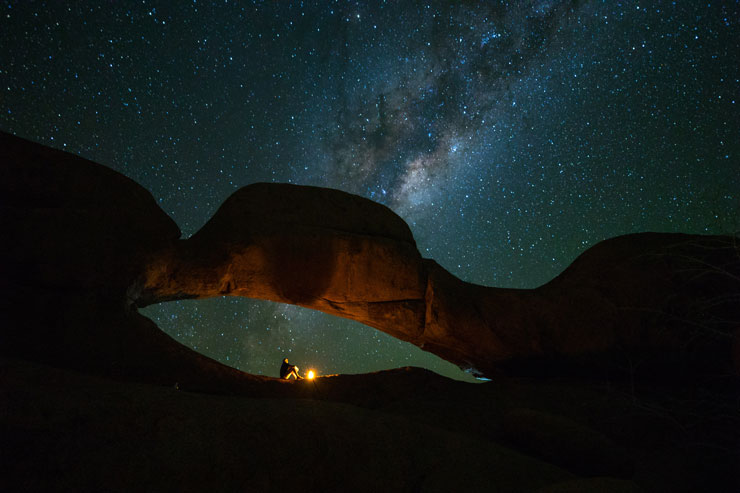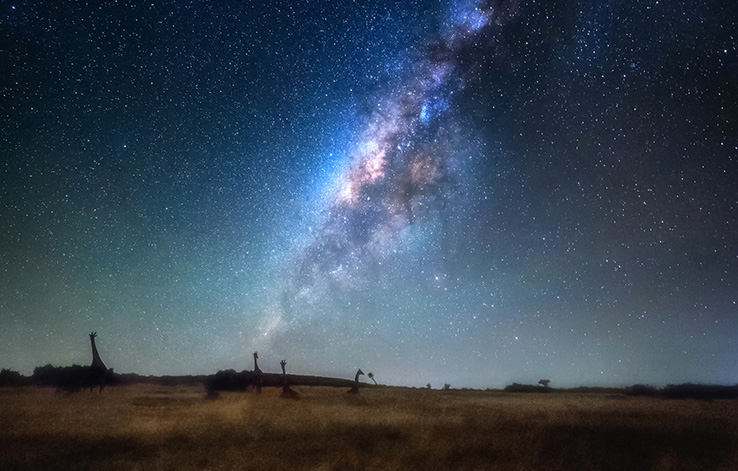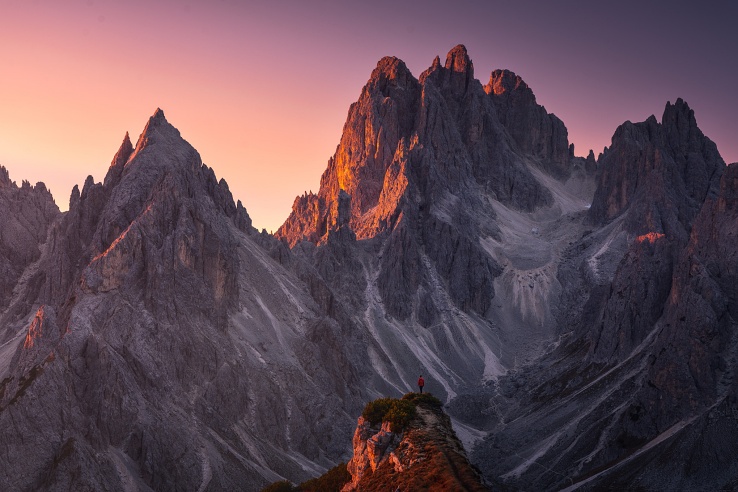The Namibia Expedition to Photograph the Milky Way is Sold Out (Join the Waiting List)
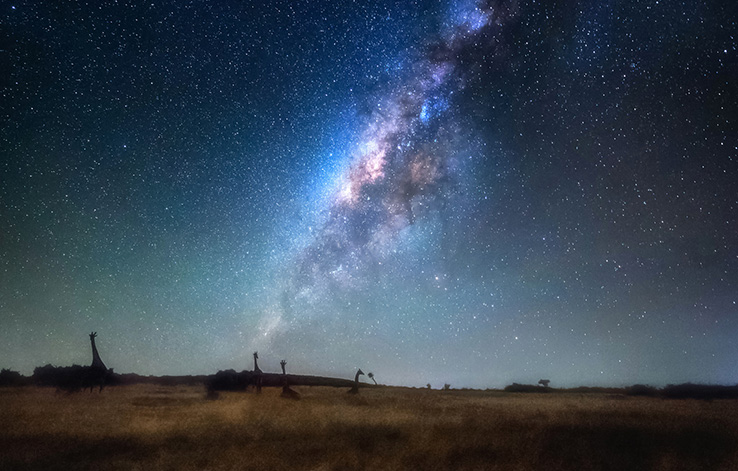
The Expedition to Namibia (September 1st-16th) is SOLD OUT now!
Wow!
All 12 spots are already gone!
Thanks so much :D
Wish to join us?
Don't give up!
Click here to join the Waiting List.
Be the first one to know when a cancellation occurs.
We’re going to Namibia...
Are you in?
Namibia has wildlife, the most ancient desert in the world, petrified trees, infinite beaches, stunning rock formations, unique tribes…
So, from September 1st to September 16th, 2018 we (the PhotoPills team) will be traveling around Namibia to photograph the Milky Way along with the soul of this African gem...
One of the darkest skies in the planet!
Of course, we’ll be taking photos all day long, but...
Can you imagine it?
To photograph the Milky Way with elephants, lions, giraffes, rock formations, millenary red dunes, the Himba and Bushmen tribes, shipwrecks...
We’re dreaming about it!
To achieve it, we’ll use the planning power of PhotoPills and the expert knowledge of our native guide to always be at the right place at the right time.
Top secret: we have quite a few legendary shots planned already ;)
It can be done!
The 2013 Astrophotographer of the Year, Mark Gee, did it in Kenya (you can see his magic in the photo above)...
We’ll do it in Namibia!
Who is in?
The Deal (only 12 spots)
Since you subscribed to the Priority Access list...
We're offering you a €500 discount on the regular price!
All you have to do is to book your spot before Sunday February 25th.
Read carefully all the details of this unique adventure.
And when you’re ready, click here to book your spot.
Please, book as soon as possible. The seats are sold on a first come, first served basis.
The Adventure
12 PhotoPillers | The PhotoPills Team | Namibia | Endless legendary pictures
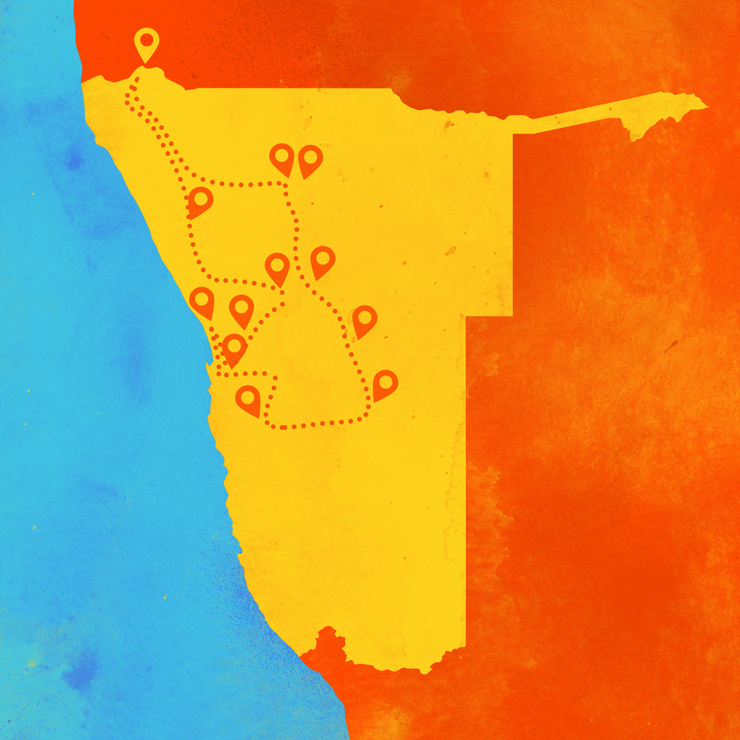
Warning: This is not a honeymoon. In Africa, we’ll sleep under the stars!
We’re recruiting 12 brave PhotoPillers (PhotoPills and photography freaks) that will join us on a 16-day expedition to photograph the Milky Way along the Namibia treasures.
It’s a non-stop safari to chase legendary pictures and you are a key asset!
Would you like to drive? Perfect... We need you!
We have planned tons of photos, and we’ll travel many kilometers to capture them...
But we also want to maximize our flexibility in terms of itinerary and schedule in order to take advantage of all the opportunities that will surely come our way.
If we come across a herd of lionesses hunting or with a group of elephants, we’ll stop and take advantage of the occasion.
When we are hungry, we’ll stop and eat. When we are tired, we’ll stop and rest (cold beer included)...
This means that we’ll travel in 4x4 vehicles perfectly equipped with water, food, camping equipment and tents. Those of you who don’t sleep in the individual tents on the vehicles will do it with us, in tents planted at ground level (and you won’t have to pitch the tents if you do not feel like it, we’ll pitch them for you).

Oh!
And do not worry about the sleeping bag and other camping equipment. The vehicles are equipped with everything necessary to survive in the desert. : P
You are about to embark on a journey following the PhotoPills style. And it’s not going to be a honeymoon precisely... :P
This adventure is going to require a lot of physical effort... But it's going to be so fun!
Are you in?
Day 1. Saturday, September 1st - Welcome to Namibia!

You land at Windhoek Airport, a modern city in the far reaches of the southern hemisphere. There, our trustworthy man awaits you. You can’t miss it: he’s wearing the yellow PhotoPills shirt.
Once the luggage is loaded in the car, you’ll leave towards the capital. Your next destination is about 40 kilometers away.
On this first night, we’ve decided to sleep at River Crossing Lodge. It’s a fantastic hotel inspired by the traditional farms of the old German settlers who occupied this land for the first time. And it has some amazing views!
6:00pm
Little by little, the rest of the PhotoPillers will be arriving...
After getting our rooms we will explore the place in search of compositions and photographic opportunities for the golden hour, sunset (6:41pm), the blue hour... and the Milky Way (8:05pm).
The African landscape, the colonial style houses, and the Windhoek skyline are very good starting points to let the imagination fly.
It’s at this precise moment when you’ll realize that you are in a different world, far from home. You are in Africa.
8:00pm
Quick snack because at 8:05 pm the Milky Way will be completely vertical in a southwest direction... And we won’t miss it!
Take out your phone and use the Augmented Reality Night PhotoPills to find the best composition.
9:00pm
While the arch of the Milky Way moves towards a cool position to capture a beautiful panoramic view, we’ll enjoy a pleasant dinner.
Dinner is served at 9:00pm in the lodge's restaurant. It will be a great opportunity to get to know each other better, review the travel plan and imagine the exciting adventures that await us.
10:30pm
The moment has come. It’s time to photograph the arch of the Milky Way for the first time in African lands.
How about starting by photographing the Milky Way arching over the capital, Windhoek?
It will be a challenge to face the light pollution of the city. :)
You have to try!
12:00am
It's time to go to bed... or not!
You can always continue photographing the stars. The light of the Moon (the Moon rises at 01:04am) will help you illuminate the foreground by capturing, for example, photos of star trails.
Photographic pills:
- Farm of German settlers (black and white, Milky Way, Star Trails).
- Landscape photography and long exposure with filters at sunset.
- Milky Way completely vertical.
- Panoramic of the arch of the Milky Way over Windhoek.
- First photos of the Namibian landscape. Arid land of low bush.
Day 2. Sunday, September 2nd - The wonders of Erindi (Part I)
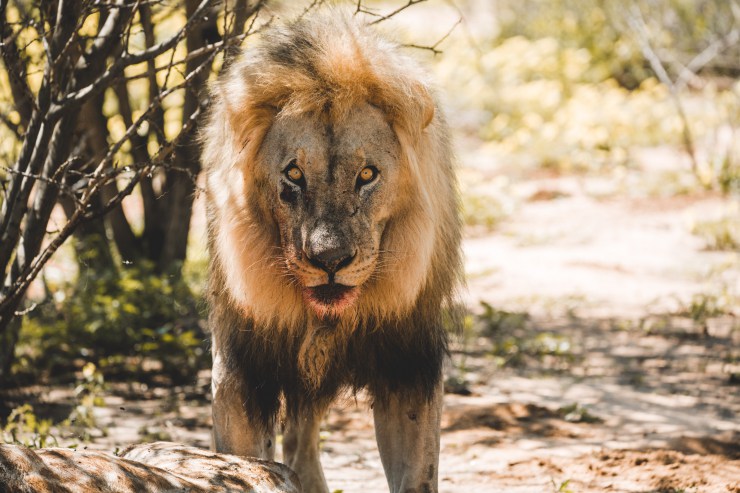
6:30am
I know you're tired from the long journey, we are too, but... You don’t want to miss the first sunrise in Africa, right?
If you’re not sure, remember the wise words of the master Galen Rowell:
“You only get one sunrise and one sunset a day, and you only get so many days on the planet. A good photographer does the math and doesn't waste either.”
So if you decide to get up early and join us, we’ll take advantage of our first African sunrise.
PhotoPills tells us that the blue hour starts at 6:37am, the golden hour at 6:46am, and the Sun comes out at 7:00am.
8:00am
Big breakfast, then we head to the capital, Windhoek.
We have to stock up on provisions for breakfast and meals. For dinners, there are small restaurants in most camps where we’ll sleep. But we have to stock up well for the road.
It will also be the time to buy some medication that could have forgotten, lip balm, sunscreen or liquid for contact lenses... this is your last chance to get it.
12:00pm
Let’s go! We’re going to Erindi, which is about 4 hours north.
We have a long journey ahead through endless dirt roads... Say goodbye to the asphalt.
Our guide goes ahead leading the expedition. He knows the terrain by heart...
An assistant is travelling with us as well. He will help us with pitching the tents... among other things.
5:00pm
Today we’ve had a meal thanks to our provisions in a beautiful spot we chose on the road. In the afternoon, we arrive at the Erindi Private Game Reserve, where many predators and antelopes roam on its 71,000 hectares.
We’ll settle in our camp: Camp Elephant.
Each camp has its own bathroom with a toilet, shower with solar heater and sink. It also has several kitchens and washing machine.
You'll have all the amenities!
We’ll park the cars, set up camp and go to discover the place.
Don’t leave the premises, remember that you are in a wild place!
Why don’t you approach the waterhole? It’s an outcrop of groundwater where animals take the opportunity to bathe and regain strength after a long day under the Sun.
It’s a place full of photographic opportunities that you can enjoy during the sunset.
The Sun sets at 6:45pm.
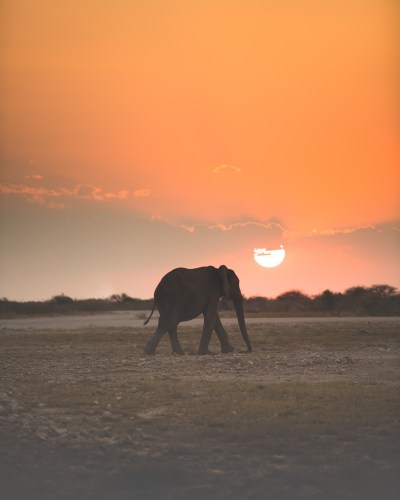
7:00pm
Dinner time!
Everyone can do it on its own. Ideally, we should all gather and cook something together.
Although it can not take us too much time...
8:00pm
At 8:07pm we'll have a fantastic opportunity to capture the Milky Way. And it will be completely vertical!
9:00pm
With hardly any time to waste, we'll board the open 4x4 vehicles of Erindi in search of giraffes, lions and elephants to photograph them with the Milky Way.
Each time we find wildlife, and without getting off the vehicle, we’ll set up the tripod on the ground (outside the vehicle), prepare the camera and take pictures. We’ll play with very high ISOs to minimize the shutter speed.
It’s a bit of a challenge!
12am
At this point you're probably wondering how long you've been here. Don’t worry about that. It’s only the second day and there are many more.
Try to sleep, if the adrenaline lets you do it...
Do you hear that? Well, yes, it's an elephant poking.
Photographic pills:
- First sunrise in Namibia.
- Wildlife that we encounter on the way to Erindi.
- Wildlife at the Erindi waterhole.
- Golden hour and sunset in Erindi.
- Vertical Milky Way in Erindi.
- Milky Way arch with wildlife in Erindi (night safari in open vehicles).
- Star Trails at the Erindi waterhole.
Day 3. Monday, September 3rd - The wonders of Erindi (Part II)
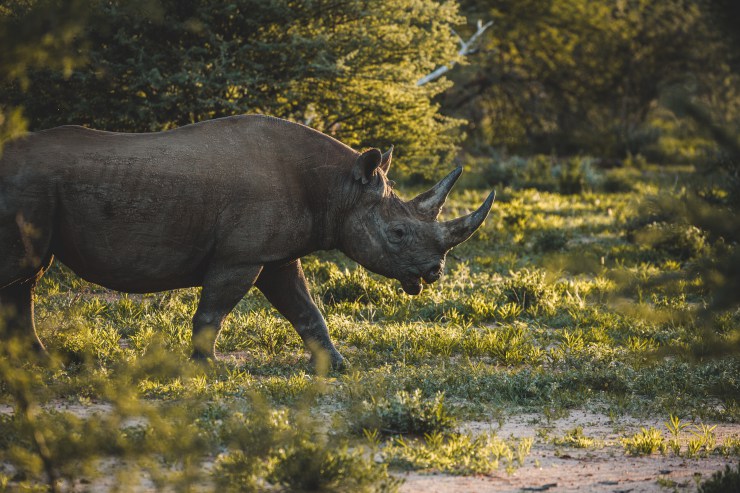
6:00am
Photos of the sunrise in Erindi (optional).
The blue hour starts at 6:38am, the golden hour at 6:47am. The Sun rises at 7:01am!
8:00am
Breakfast.
9:30am
Today, you have a planning class of the Milky Way and Star Trails using PhotoPills. We want you to return home mastering PhotoPills.
11:00am
The Milky Way post-processing class begins.
It’s the perfect time to take out the laptops and process the photos of the Milky Way captured so far.
12:30pm
Time to eat and rest.
There is a bar about 20 km away. If you feel like it, we can organize an expedition to eat over there.
4:00pm
In Erindi there is much more than the waterhole of Camp Elephant. So we’ll get on our vehicles and we’ll go on safari in search of animals during the best light of the day.
The Sun sets at 6:45pm.
7:00pm
Back to the camp, we'll park the vehicles and pitch the tents.
Then, it’s dinner time!
8:00pm
At 8:07pm you have a new opportunity to photograph the Milky Way. Once again, it will be completely vertical.
But this time we want it to be different... Let's try to photograph the Milky Way with a very old tribe: the Bushmen.
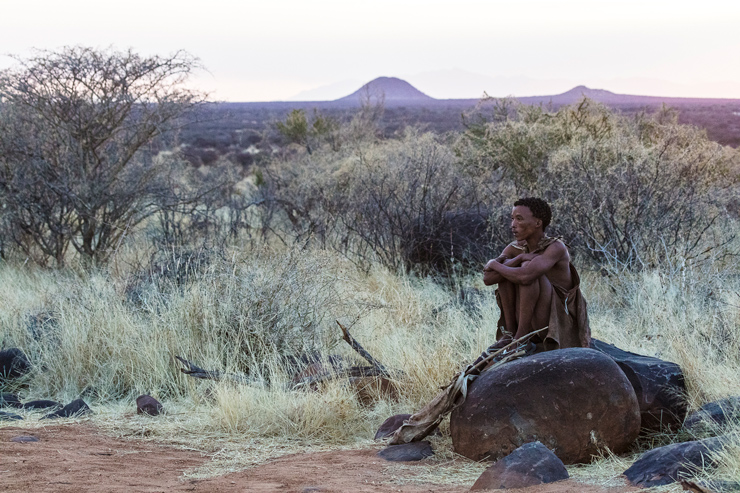
9:00pm
Once again we’ll pursue our dream. We’ll board the open 4x4 vehicles of Erindi in search of giraffes, lions and elephants to photograph them with the arch of the Milky Way.
Second try!
12:00am
Off to bed! In the morning another safari awaits you.
Photographic pills:
- Sunrise in Erindi.
- Wildlife in the Erindi waterhole.
- Wildlife during the afternoon safari in Erindi.
- Golden hour and sunset in Erindi.
- Vertical Milky Way in Erindi with the Bushmen.
- Milky Way arch with wildlife in Erindi (night safari in open vehicles).
- Star Trails in the Erindi waterhole.
Day 4. Tuesday, September 4th - Sunrise in Erindi and sunset in Etosha
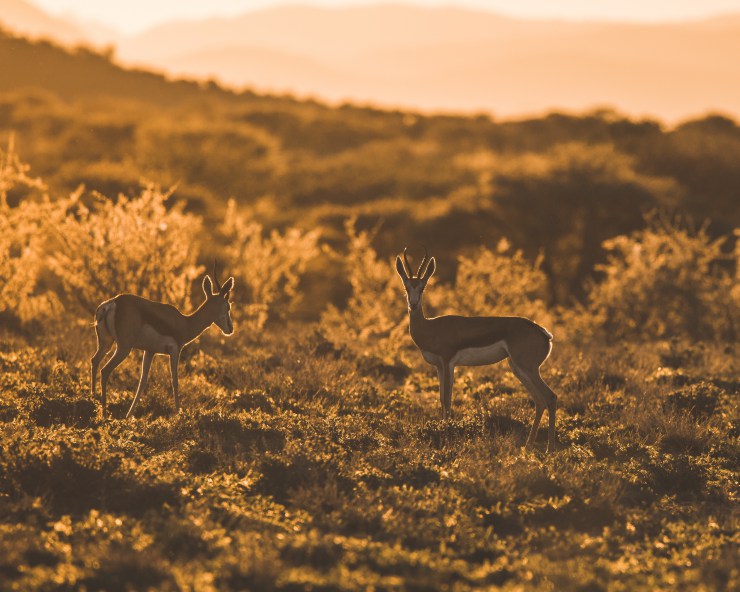
6:00am
We’ll get up to get back to the 4x4 open vehicles of Erindi. We’ll track all kinds of animals to photograph them during the golden hour and at sunrise (7:00am).
10:00am
After a shower, we’ll dismantle the camp. And after a good breakfast, we’ll check the map and head towards the northeast. We are going to Etosha, one of the most spectacular national parks in Namibia and the African continent.
We’ll have lunch along the way. Today we’ll sleep in Etosha.
4:00pm
We arrive at Von Lindequist, one of the gateways to Etosha. And after arranging the papers with the rangers, we entered the national park... Astonishing.
The Sun sets around 6:44pm, so we’ll use the rest of the afternoon to photograph the wonders of Etosha with the best light, during the golden hour, the blue hour and the sunset.
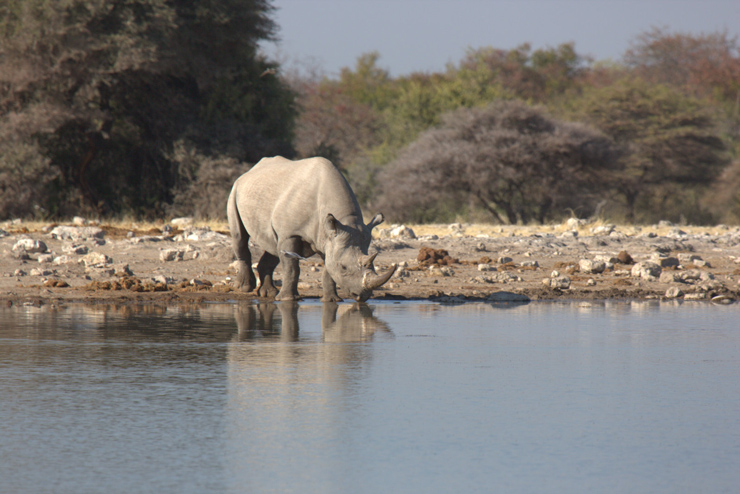
8:00pm
After the long journey, we’ll go to Namutoni Campsite, a camp with all the comforts within Etosha!
We’ll park our vehicles, pitch our tents, take out the tables and chairs... And after a nice shower, we’ll prepare a more than deserved dinner (what about a barbecue?) and we’ll go to bed soon. Tonight it's time to recover.
Etosha awaits us tomorrow.
10:00pm
In the camp there is a spectacular waterhole... It will be difficult to resist the temptation to photograph the wildlife it attracts along with our galaxy.
Photography pills:
- Wildlife and sunrise during the safari with open vehicles in Erindi.
- African savannah and the opportunities that arise on the way to Etosha.
- Vertical Milky Way in Etosha (optional).
- Arc of the Milky Way in Etosha (optional).
- And don’t forget to take pictures of our dinner under the stars.
Day 5. Wednesday, September 5th - Etosha 4 Bigs
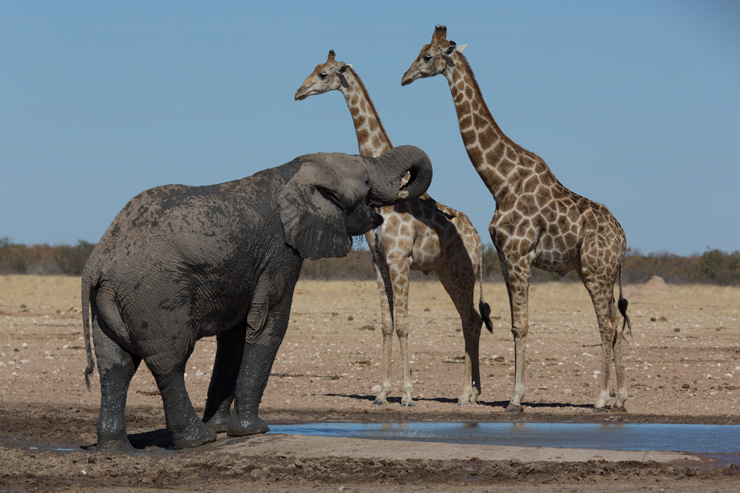
6:00am
In its more than 22,000 km of incomparable landscapes, Etosha is home to 114 species of mammals, including four of the Big Five: lion, leopard, elephant and rhinoceros. It is also the habitat of more than 400 species of birds and 110 species of reptiles... Many reptiles!
In addition to this, among its treasures are three species of antelope: the beautiful black-faced impala, the elegant roan antelope and the small Damara dik-dik, the smallest antelope in southern Africa, that is only 40 cm tall.
We’ll get on our vehicles and we’ll drive in search of the Big Four of Etosha.
We’ll capture the sunrise (sunrise is at 6:56am).
9:00am
At some point we'll stop for breakfast and then continue our safari through the Etosha savannah. Our expert guide will lead us to the most frequented waterholes.
In the central part of the park, our eyes will be delighted with the white landscape by the salt crust of Etosha Pan, an ancient lake that was once fed by the waters of the Kunene River. The tectonic movements of the Earth's crust altered the course of the river condemning the Pan to become what it is today: a white desert full of animal life!
By the way... In Etosha it’s out of question getting off the vehicle, it’s big cats’ territory.
1:00pm
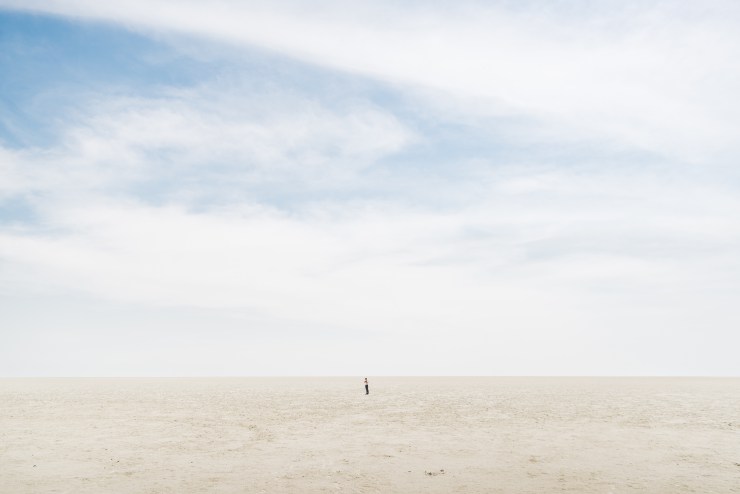
We’ll stop our expedition through the park to rest, cool off and have lunch in the middle of the savannah. But keep your eyes open in case something unexpected suddenly happens.
We’ll continue crossing Etosha in search of all kinds of animals until sunset (6:45pm). Remember, today we also sleep inside the park, so we’ll take advantage of the moments of better light!
7:00pm
Okaukuejo Campsite is our camp for today. It’s located in Etosha, about 17 km from the Anderson gate.
The camp has all the amenities... And a spectacular whaterhole where we can wait for the night watching the animals drink. And when the Milky Way is in position... we’ll be there, ready for what may happen. :P
11:30pm
You'll be tired today but you can only hear the wind, some animals through the canvas of the tent... And the noise of the camera of some PhotoPillers photographing the Milky Way.
Tomorrow a great day awaits... we'll start a long journey to the Himba.
Photographic pills:
- Sunrise in Etosha.
- Wildlife in Etosha. We’ll look for the Big Four in the savannah and the waterholes.
- The whiteness of Etosha's salt crust.
- Sunset.
- Photos of the Milky Way and Star Trails in the Okaukuejo waterhole.
Day 8. Thursday, September 6th - In search of the Himba (route to Epupa)
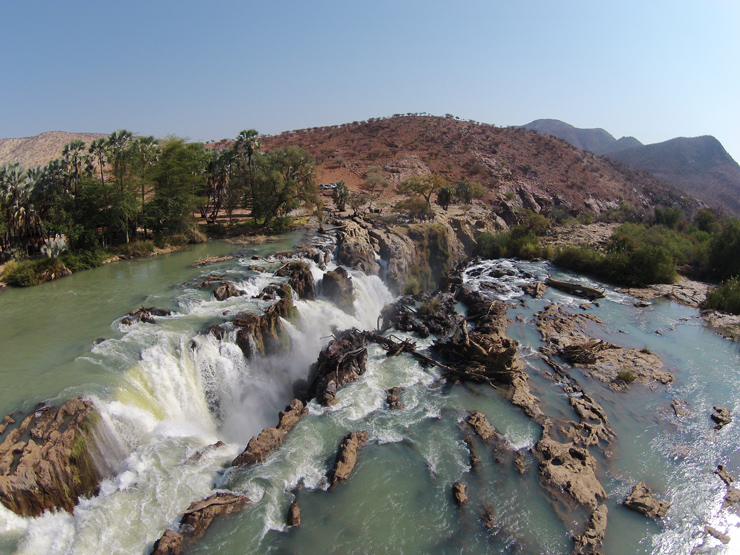
6:00am
Last sunrise in Etosha before continuing our adventure towards the northwest, towards Angola... in search of one of the most attractive tribes in the world: the Himba.
It’s a community that lives in the Namib, both Namibian and Angolan, and that continues to cover their skin with a red mud that makes them unmistakable. These are strong and proud people that have developed a way of life according to their environment.
The Sun rises at 7:01am.
9:00am
After a hearty breakfast, it's time to get in the car!
Today we’re going to travel many kilometers to our next destination. But believe me, it’ll be worth it.
We want to enjoy a more authentic experience with the Himba, fleeing tourist places.
To achieve this we'll enter a spectacular territory (less known) until we reach the border with Angola. There we'll settle very close to the Epupa waterfalls (on the Kunene river)... which, despite not having much water at this time of year, is a spectacular place to photograph the sunset (the Sun sets at 7:01pm).
Along the way we'll take advantage of the photographic opportunities that arise... And we'll stop to eat and cool off when we need it.
6:00pm
We’ll settle in the Omarunga Campsite in Epupa, close to the Kunene River and next to the Epupa Falls.
After a long day, we’ll make an effort to explore the area and look for our compositions for the sunset... and for later on, including the Milky Way.
10:00pm
After a good dinner under the stars, it's time to rest.
Tomorrow we'll visit the Himba.
Photography pills:
- Sunrise in Etosha.
- Photographic opportunities on the way to the Angolan border.
- Sunset and Milky Way in the Epupa waterfalls.
Day 7. Friday, September 7th - The Himba
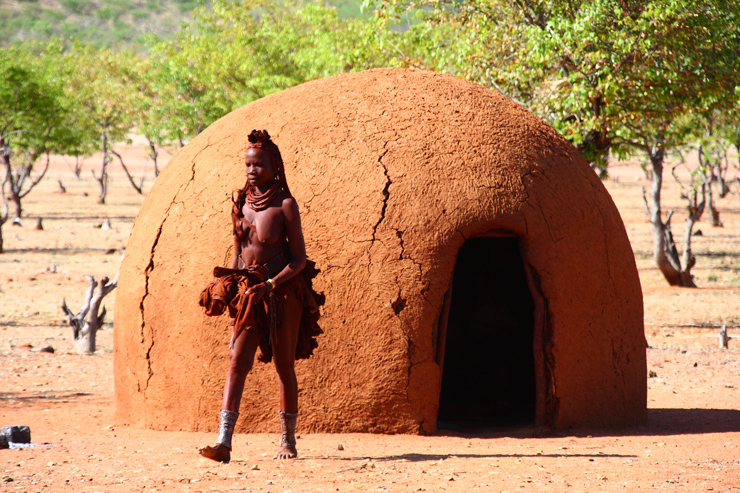
6:00am
Optional sunrise on the river Kunene. The Sun rises at 7:09am.
8:00am
We’ll spend the morning with the Himba, learning their customs and taking photographs.
Although, besides that, we have a very important mission to take care of... Find among the members of the tribe some volunteer(s) who let us photograph them at night, under the stars.
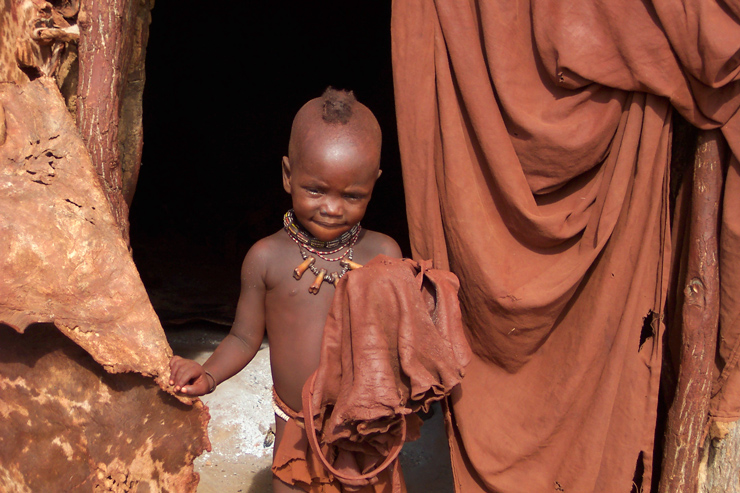
1:00pm
When we’re hungry, we’ll take a short break to have lunch and have some rest.
3:00pm
Free afternoon to rest in the camp or to continue enjoying Epupa. There are many routes that can be done on foot.
Or maybe you want to join an expedition in search of crocodiles... There are many options to have fun.
6:00pm
The Sunset is at 7:01pm. It's time to look for our compositions. We must work in advance!
Then, we'll have dinner slowly but surely... because the Milky Way doesn’t wait for anyone.
8:00pm
The astronomical twilight ends at 8:13pm, just when the Milky Way is completely vertical. And at 11:30pm it will be perfectly located in the sky to capture a panoramic view.
We have several hours ahead to enjoy a dark and starry sky.
And if the negotiations have gone well in the morning... We’ll be together with our hosts, the Himba.
12am
Today we’ll sleep again at the Omarunga Campsite.
Tomorrow more... Sweet dreams!
Photography pills:
- Sunrise at the Epupa and Rio Kunene waterfalls.
- The Himba and their town.
- Sunset at the Epupa and Rio Kunene waterfalls.
- Milky Way and the Himba.
Day 8. Saturday, September 8th - Khowarib gorge
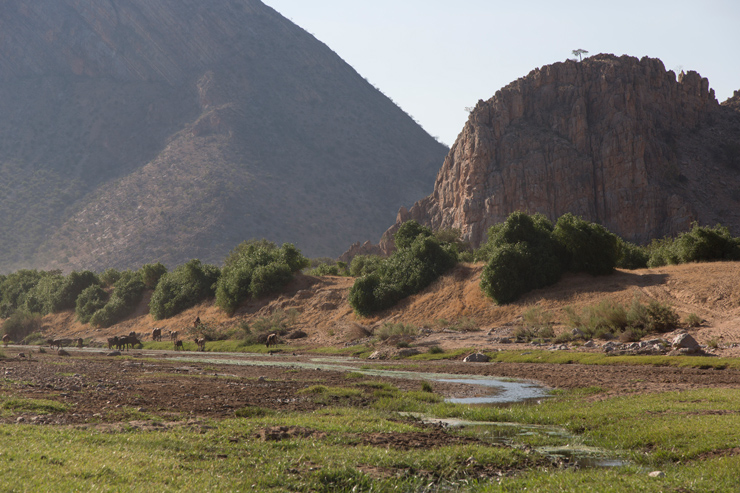
9:00am
After a refreshing shower and a more than deserved breakfast we head south towards Damaraland, a land full of mysteries and treasures (desert elephants, rock formations, rock art...).
Today we have a long route to our next destination: Khowarib gorge.
So we’ll stop to rest and eat when we need to then resume our route.
4:00pm
Khowarib gorge offers multiple photo opportunities and our camp, the Khowarib Community Campsite, is in an unbeatable position to access it.
While we’re crossing the territory, we’ll find a good location to capture the sunset... and for the night photography that will come afterwards.
9:00pm
And when we start to feel tired, we’ll return to our camp for dinner, relax and rest.
Photography pills:
- Sunrise in Epupa.
- Sunset in Khowarib gorge.
- Milky way and Star Trails in Khowarib gorge.
Day 9. Sunday, September 9th - Desert elephants and the Vingerklip (the finger rock)
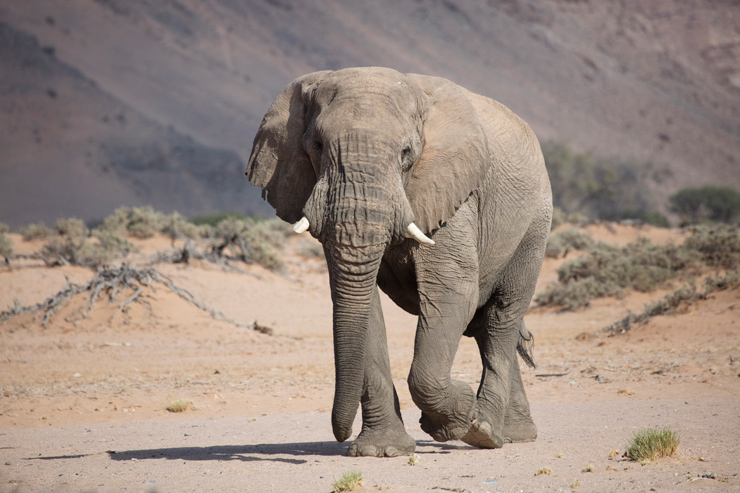
9:00am
After breakfast we’ll head to the valley where Twyfelfontein is located, an archaeological site declared a World Heritage Site by UNESCO. Here you can see more than 2,000 figures of rock art and archaeological remains more than 3000 years old.
But first, we’ll stop to photograph a very peculiar forest: a petrified forest. In fact, it is not a forest exactly. Rather it is an accumulation of petrified tree trunks... of more than 280 million years!
Another attraction of Twyfelfontein is a rock formation known as Organ Pipes. These are structures formed 150 million years ago when liquid lava was introduced into a slate rock formation. They resemble the structure of tubes of a large organ, hence its name.
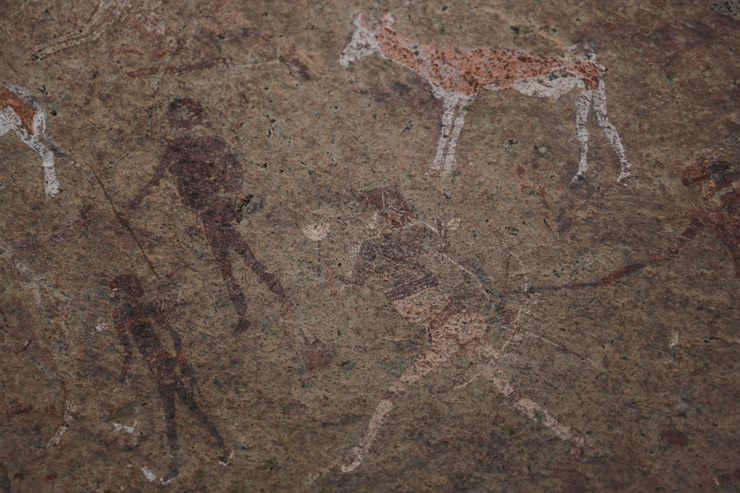
12:00pm
In this area of Damaraland, we can see the desert elephants. :)
These elephants are tough as a rock. They have learned to survive the harsh conditions of the desert, with very little water. This extreme situation has led them to develop unique conditions. They are thinner and taller than the rest of the African elephants. And they even have wider hooves.
They are not easy to see, so we’ll be on safari tracking them with the help of our guide.
3:00pm
We'll resume our journey, crossing Damaraland towards the terraces of Ugab, where a spectacular rock formation awaits us: the Vingerklip.
Known as the "finger-shaped rock" or, as we call it, the "finger of the gods", the Vingerklip dominates the Ugab valley from the top of a hill thanks to its 35 meters high.
Yes, I know... We all dream of making a panoramic view of the Milky Way over the rock... But patience because we’re not there yet. I can’t wait!
Along the way, we’ll look for all the photographic opportunities that come our way. Remember that we are in Africa. At any moment something unexpected can happen so you have to be vigilant.
Our camp, the Ugab Terrace Campsite, is only a 15-minute drive from the Vingerklip. There, we’ll stop to rest, cool off and eat something.
I don’t know about you, but I plan to go to the bar (yes, this camp has a bar nearby) and enjoy a cold beer. Then I’ll take a good nap because even though we are in Africa, I’ll keep my old good habits.
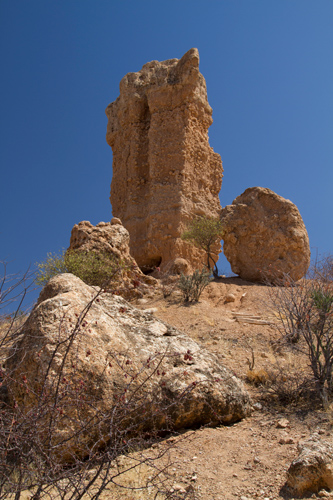
6:00pm
The Sun sets at 6:51pm. And there are many photo opportunities with the Vingerklip as the main subject. We’ll teach you how to use PhotoPills to find them.
We’ll be in the right place and time to capture a spectacular photo of the sunset with the rock formation.
And when the day goes out, we’ll have something to eat, rest and find a good spot to wait for the Milky Way.
8:00pm
We’ll shoot our first night photography at 8:05pm, combining the vertical axis of the rock with our completely vertical galaxy...
And we won’t stop taking pictures until after midnight.
One of the most exciting moments will happen around 11:45pm, when the Milky Way forms a perfect arc on our subject, the Vingerklip.
Can you imagine the photo?
1:00am
Today we'll sleep soundly. Happy with all the images we captured.
Photography pills:
- Desert landscapes of Damalarand.
- Rock art, petrified forest and Organ Pipes.
- Elephants of the desert.
- Sunset in the Vingerklip.
- Vertical Milky Way, panoramic and star trails in the Vingerklip.
Day 10. Monday, September 10th - The majestic Spitzkoppe
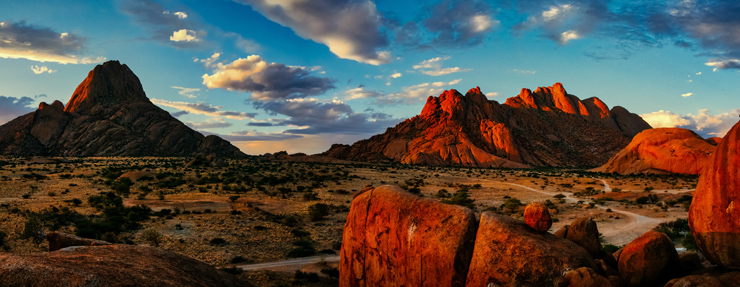
6:00am
Today we’ll get up early. We have tons of things to do.
And let's start strongly photographing the sunrise with the Vingerklip. The blue hour starts at 6:38am, so you have to be ready. :)
9:00am
A good breakfast and then to the south... towards Spitzkoppe!
Its 1,728m high make Spitzkoppe is one of the icons of Namibia. This rock formation is located in the desert of Namib, between the towns of Swakopmund and Usakos... And its form inspired its nickname: the Africa "Matterhorn".
Spitzkoppe hides many secrets that we’ll discover just after a brief stop to rest in our camp, Spitzkoppe Rest Camp.
6:00pm
We’ll rest, but not much. The Sun sets at 6:52pm just west of the spectacular rock formation... At that moment we’ll capture one of the most legendary moments of our Namibian adventure.
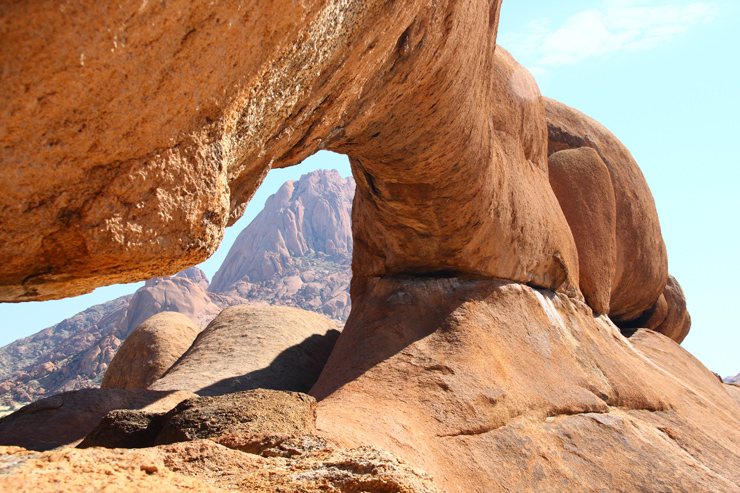
8:00pm
As usual, we’ll eat something on the fly. Because when you love photography, you forget to eat. It happened to us in Iceland several times. I’m not joking!
There is no time to waste... The dance of the Milky Way begins.
First vertical, then diagonal and finally horizontal, to capture a beautiful panorama.
Oh!
I haven’t told you, but there is also a natural stone arch hidden in the area. Ideal for the night... Top secret! ;)
Photography pills:
- Sunrise at the Vingerklip.
- Sunset in Spitzkoppe.
- Milky way in Spitzkoppe (and its secrets).
Day 11. Tuesday, September 11th - Sea lions, shipwrecks and skeletons
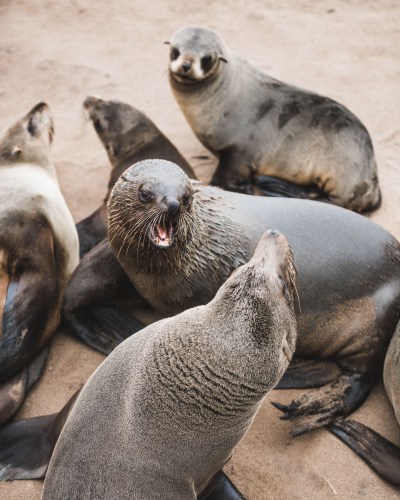
6:00am
Time to wake up!
At 7:00am the Sun rises just east of Spitzkoppe (the blue hour starts at 6:37am). The direction of the golden light of dawn will bathe laterally the rock formation bringing out all its volume and beauty.
10:00am
And after so much drought and arid landscapes, we reach the coast. We’ll go in our cars until we come across Swakopmund, one of the most important fishing grounds in the world.
And there is a reason for this. This side of the Atlantic are bathed by the Antarctic current. Here the waters are very cold and are loaded with krill and micro plankton that attract all kinds of fish and cetaceans. On this coast has also one of the largest colonies of sea lions in the world.
We’ll enter Swakopmund, which resembles a Bavarian city. It’s weird to leave a primitive desert and enter what looks like a European, colonial city to enjoy a frankfurter sausage with sauerkraut and a giant beer... All in German fashion.
We’ll stroll around its streets for a while.
Afterwards, we'll settle in our bungalows in Swakopmund. At last we’ll have a room with all the comforts!
3:00pm
After a while resting, we’ll head to the Cape Cross Seal Reserve, where a colony of more than 210,000 sea lions live. Awesome!
On the way to the reserve, we’ll stop for a moment to locate the remains of a shipwreck. And we’ll look for the best compositions to capture it with the stars.
Then, we’ll continue our trip to meet the sea lions. We’ll enjoy them until sunset (6:57pm).
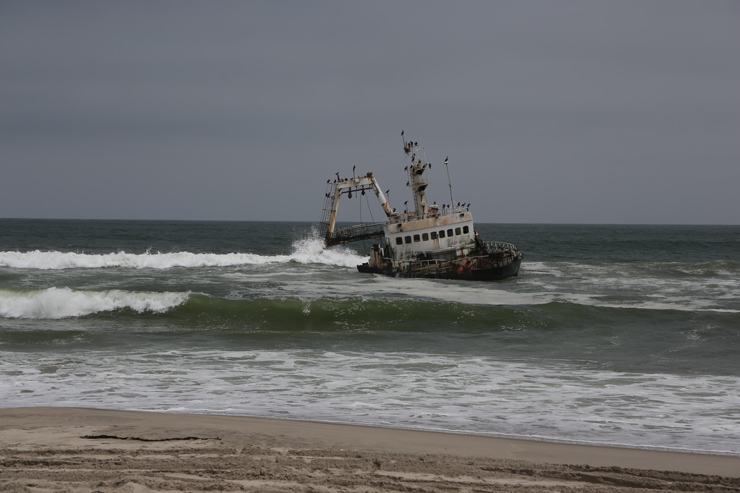
8:00pm
Brief stop on the way to photograph the shipwreck with the vertical Milky Way. Then, to the hotel where dinner awaits us. I’m so hungry!
Photography pills:
- Sunrise on Spitzkoppe.
- The town of Swakopmund.
- Sea lions and sunset at Cape Cross Seal Reserve.
- Milky Way with the remains of a shipwreck.
Day 12. Wednesday, September 12th - The secret
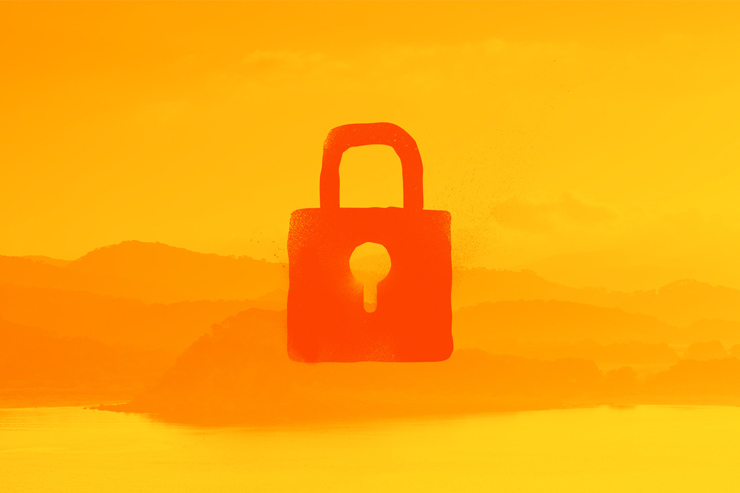
I’ve been giving you many details of this crazy expedition to Namibia.
Maybe, even too many...
But on September 12th we’ll do something completely different. So different and fun that we’ve decided to keep it secret.
You'll have to be there, with us, to find out. :P
Day 13. Thursday, September 13th - Deadvlei: The dead forest
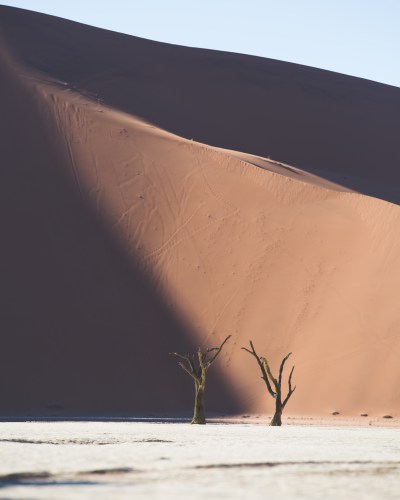
9:00am
After cooling off on the coast, we head to Sossusvlei, the Namib-Naukluft National Park, the field with the highest dunes in the world.
These are red dunes of oxidized iron, covered with small vegetation that hydrates with the Atlantic breezes and that gives a touch of color a little ocher, red and blue.
We’ll see the famous deadvleis, those areas between dunes with petrified trees and white salty soils. The dream for any photographer.
11:00am
Throughout our journey we’ll stop at some highlights. Among them is the Tropic of Capricorn, you know, to take the obvious tourist photo...
But we'll also stop to photograph one of the most spectacular plants on the planet. The Welwitschia mirabilis, an endemic specimen of the Namib desert.
Believe it or not, these plants can live up to 2000 years!
2:00pm
We’ll enter the Sossusvlei park and stop at our camp, Sesriem Campsite. It has a restaurant where we can eat and cool off with a cold beer.
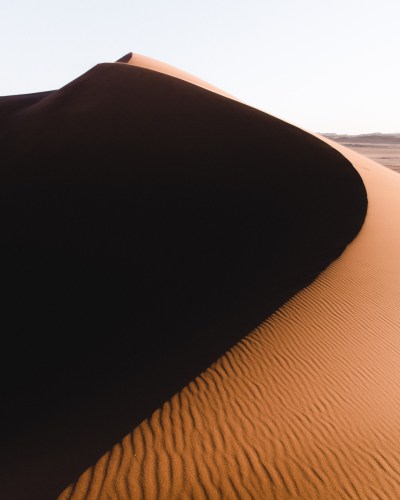
5:00pm
We are in Deadvlei, face to face with the mysterious petrified trees, looking for our compositions... And waiting for the golden hour to come (6:21pm).
An afternoon full of emotions awaits us.
8:00pm
We get to our camp. We have dinner and prepare to photograph the Milky Way with the beautiful dunes of Sossusvlei.
Photography pills:
- Welwitschia mirabilis, the endemic plant of the Namib desert.
- The sign of the Tropic of Capricorn (time to act like a tourist).
- Sossusvlei and its sea of dunes.
- Sunset in Deadvlei and the petrified trees.
- Milky Way with the dunes of Sossusvlei.
Day 14. Friday, September - The Sossusvlei dunes red sea
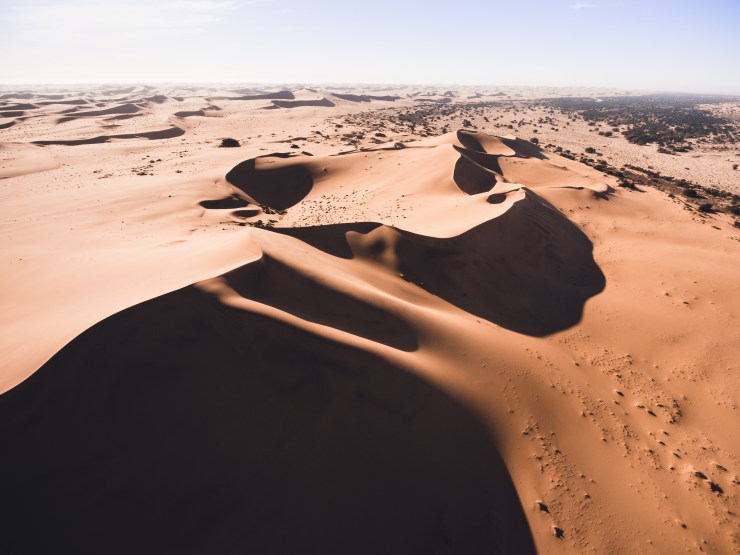
6:00am
Today we’ll spend all day exploring Sossusvlei... From sunrise to sunset!
We’ll visit its highlight locations, including: Deadvlei, the Big Daddy dune, the dune 45, the hidden desert, the Sesriem canyon, the petrified dunes, the Elim dune... In short, everything we can cover. :)
The Sun rises at 6:58am and sets at 6:51pm... This will be a long and very entertaining day.
8:00pm
We’ll be tired, but...
It’s fine! We’re in Namibia. We'll rest when we return back home.
After enjoying dinner in our camp, we’ll continue to take photos.
Look there!
The desert, the dunes and our galaxy.
Photography pills:
- Deadvlei.
- Big Daddy
- Dune 45
- Hidden desert
- Sesriem canyon.
- Petrified dunes
- Dune elim.
- Sunrise, sunset and Milky Way.
Day 15. Saturday, September 15th - Decompression under the stars of the Kalahari
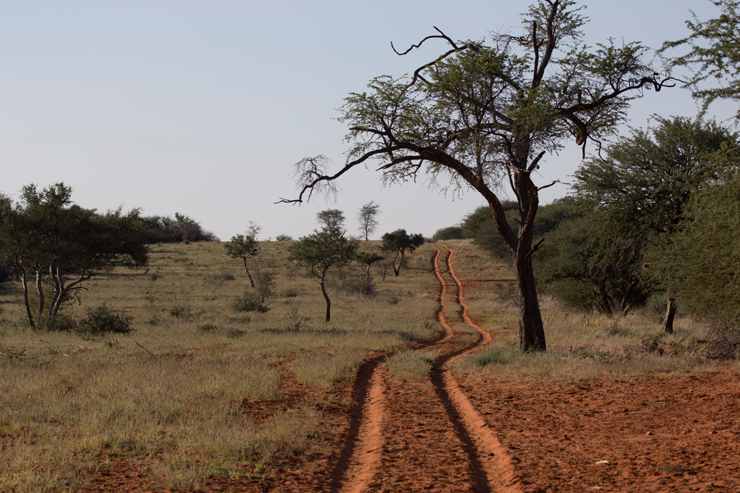
10:00am
The decompression begins.
After sleeping soundly and a hearty breakfast, we continue our route. This time, we head east, through the Namibian Kalahari.
In this area of the Kalahari we’ll have one last chance to photograph something that we missed, cheetahs, brown zebras, red dunes maybe... Or, something new.
It’s Bushmen territory...
2:00pm
We’ll settle in the Bagatelle Campsite, a camp in the heart of the desert but with all the comforts.
Here we can see how they feed the cheetahs. An amazing show.
We’ll have free time during the rest of the afternoon, so you can do pretty much what you want. Rest, explore...
Today it's time to relax, edit photos and enjoy a bit of tranquility. Unfortunately, the trip is coming to an end.
But before the farewell, we want to invite you to dinner in the middle of the desert, under the stars.
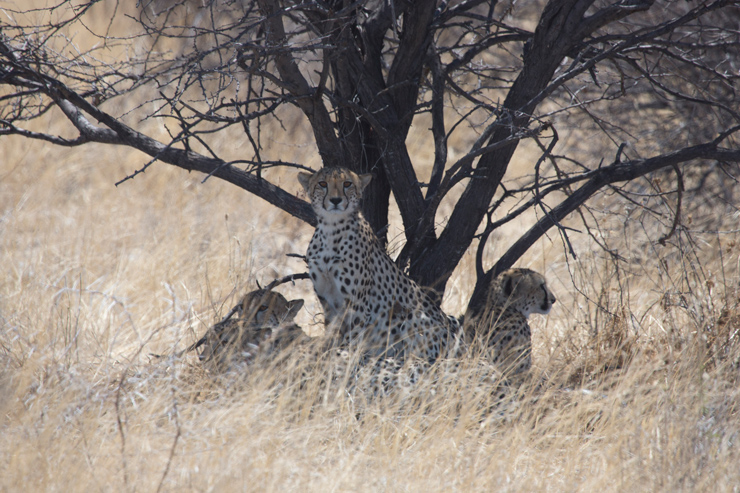
8:00pm
We’ll go to a remote location in the desert, where they’ll be waiting for us with the table set. It's not a restaurant, but we won’t have to cook either. We’ll be amazed by the local chef.
It will be our last dinner in Namibia... And we’ll remember it for the rest of our lives.
Day 16. Sunday, September 16th - Life goes on…
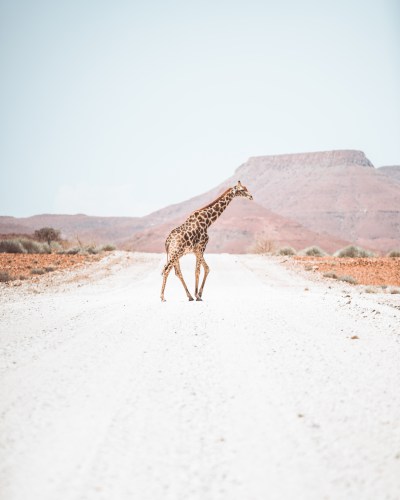
The Sun rises...
Breakfast and we go to Windhoek.
The camp is about 4 hours from the airport, so it is important to fly in the afternoon so you don’t have to get up early. Or better yet, fly on Monday.
It's time to say goodbye.
See you soon friends!
Life goes on...
Book now and save €500 (only 12 spots)
To book your spot to join the expedition to Namibia at a reduced price of €4,500 (the official price is €5,000), a €1,000 deposit is required by Sunday, February 25th.
Payment in full is required by May, 30th 2018.
Please, finalize your booking as soon as possible. The seats are sold on a first come, first served basis.
What’s included in the price
- Pick up at Windhoek airport and transfer to the hotel. Transfer to Windhoek airport at the end of the adventure.
- A 16-day expedition photographing the essence of Namibia with the Milky Way (and the best light)
- 16 days of learning, fun and adventure with the funniest geek community: PhotoPillers.
- Immersion in the PhotoPills method (Imagine.Plan.Shoot.).
- Local guide and local assistant.
- Rental of 4 4x4 vehicles equipped with all the camping gear.
- 8 tents for individual use pitched on the roof of the vehicles (2 tents per car). And 2 spacious double tents pitched on the floor for shared use. Both our guide and we, the PhotoPills team, will sleep in the shared tents planted on the ground.
- Gas.
- Night photographic safari with open vehicles in Erindi (2 nights).
- Photographic safari sunrise with open vehicles in Erindi.
- Photographic safari with our vehicles in Erindi.
- Tickets to Etosha National Park.
- Excursion to visit the Himbas.
- Entrance to Damaraland (Twyfelfontein, Organ Pipes, Burnt Mountain, Petrified forest...)
- Entrance to the Cape Cross Seal Reserve.
- Entrance to the Namib-Naukluft Park (Sossusvlei).
- Entrance to visit cheetah feeding in Kalahari.
- Surprise activities on September 12th.
- Lodging in double rooms, dinner and breakfast at River Crossing Lodge.
- Camping in Camp Elephant, Erindi (2 nights).
- Camping in Namutoni Campsite.
- Camping in Okaukuejo Campsite.
- Camping in Omarunga Campsite Epupa (2 nights).
- Camping in Khowarib Community Campsite.
- Camping in Ugab Terrace Campsite.
- Camping in Spitkoppe Rest Camp.
- Accommodation in Swakopmund bungalows, in double rooms (2 nights).
- Camping in Sersiem Campe Site (2 nights).
- Camping in Bagatelle Camp Site.
- Farewell dinner in the Kalahari desert.
What’s not included
- Flights to/from Namibia.
- International medical and travel insurance coverage (mandatory).
- All meals and beverages, except those expressly indicated in "What’s included in the price". Those who wish may join our common fund to buy food and water. Most camps have a restaurant where everyone can have whatever they want at any time.
- Tips.
- Alcohol.
- Laundry.
- Everything not included in the “What’s included in the price” section.
Do you want an example of how huge this will be?
This is a glimpse to what happened in the PhotoPills Expedition to Iceland... But we had so many adventures and so much fun... We can’t wait for Namibia!
But you don’t have to take our word for granted. Here’s what some PhotoPillers say about the PhotoPills adventures:

“I went to Iceland expecting to have the opportunity to photograph the marvelous landscape and master nightscapes. What I encountered was so much more – 14 kindred souls from across the globe who share a passion for photography. Together we expanded our creative boundaries, learned from one another and had an insane amount of fun in the process. I am confident that everyone came away from the experience a better photographer.” - Warren Hatch, USA

“From the very moment the guys from PhotoPills announced the expedition to Iceland... I didn’t think it twice! I was using PhotoPills but not at its full capacity, so I had no better chance to learn from the creators of this amazing app. The experience was even more amazing than anything I could have imagined. In Iceland, I discovered a bunch of folks as crazy about photography as I am. I had a blast!
Photography is a continuous learning process, you always find something new that motivates you to improve. And this adventure made me improve more than I could imagine.” - Leonardo Villa, Colombia

"The PhotoPills guys know how to create a fantastic experience. They bring an infectiously fun energy and are always willing to drop some handy photography knowledge on you that you will take with you. You take their trip and you'll for sure have a good time, get some amazing pics and leave a better photographer." - Patrick Rory , Canada

“During my experience in Iceland I lived wonderful moments and had surprises that were beyond the expected. It completely exceeded my initial expectations! Sharing knowledge, experiences and ways of working and living photography with such a great group has been one of the most enriching life experiences I have ever had.
Who he said that learning and knowledge sharing can not be wonderfully fun?” - Carlos F. Vásquez, Colombia

“I can't say enough about what a fantastic time I had during the PhotoPills Iceland photo tour! The guys from PhotoPills and Donal Boyd were so knowledgeable, accommodating, and especially lots of fun. Never a dull moment – nonstop action and shooting of amazing landscapes for 10 days. I came away with enough images and memories to last a lifetime!” Jana Kalous, Canada
FAQs
What’s the temperature in Namibia in September?
September is a very nice month. It’s dry and the skies are clear. It’s not too hot nor too cold. It cools down at night. Temperature varies depending on the area but you should expect the range to be between 50ºF (10ºC) and 86ºF (30ºC).
It’s key to wear in layers to be able to adapt to any temperature change.
Do I need vaccinations?
Vaccinations depend on where you’re traveling from and on your personal health. Please, check it with your doctor.
What do you recommend I bring along for the Expedition?
Your sense of adventure and fun, your camera and of course your sense of humor.
Besides that? When you book your seat, we’ll send you a Information Package that will give you further details and suggestions about what to bring (gear, clothing, etc).
Is travel insurance included in the price of the expedition?
No. Participants are required to purchase international medical and travel insurance coverage.
We recommend you to choose a travel insurance that covers trip cancellation costs.
What is the cancellation policy?
We hope you don’t need to cancel your spot, but if a situation arises where you don’t have a choice, our cancellation policy is the following.
If you cancel and the expedition to Namibia is otherwise filled, we'll refund you the full booking fee you have paid, minus a €300 administrative fee.
If you cancel and the expedition to Namibia does not fill, then you will be refunded according to the following schedule, based on the full fee of the expedition:
- 90 days or more before the expedition: 100% refund, minus a €300 administrative fee.
- 60-90 days before the expedition: 50% refund, minus a €300 administrative fee.
- 60 days or less before the expedition: No refunds will be given.
Refunds will be paid by the same method that the original payment was made.
Credits: Cover image by Mark Gee. Rest of the images by Donal Boyd and Heiner Dillmann ([email protected]).
